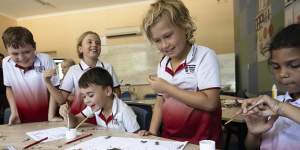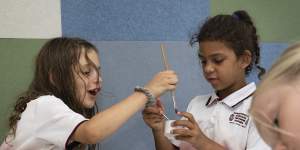The story is long,and sometimes Darruy stumbles,but he carries on with the help of classmates Elsie Peckham and Jayalaani Webb,recounting the Dreamtime tale in the language of the Gumbaynggirr people.
Children from the Gumbaynggirr Giingana Freedom School in Coffs Harbour recount a Dreamtime story they have learnt in the Gumbaynggirr language of the mid-north coast.
The fact that the children are doing this – in 2024 – almost has Gumbaynggirr language teacher Michael Jarrett in tears.
Forty years ago,his ancestral language was on the brink of extinction,rescued only by the efforts of a group of elders in the 1980s who pooled their pensions and used an old abandoned church near Kempsey to record their words,songs and stories and pass them on to younger generations.
“If those old people could come back and have a look at how this language has grown,they’d be so,so proud – because they saw the language die,” Jarrett says. “They’d probably say,‘Yeah,we’ve done our job … the Gumbaynggirr people have taken up the challenge to keep that language alive.’ ”
Jarrett has taught Gumbaynggirr to thousands of adults over the past four decades at the Muurrbay Language Centre in Nambucca Heads,and his former students now teach it in schools along the Mid-North Coast,including at Darruy’s school,the Gumbaynggirr Giingana Freedom School in Coffs Harbour.

Students of Gumbaynggirr Giingana Freedom School make artwork from items they found on Country in Coffs Harbour.Janie Barrett
It became the state’s first bilingual Indigenous language school when it opened in 2022 with 15 students. It now has 71,from kindergarten to Year 6,as well as a waiting list,aspirations to extend to Year 12 if it can find more space,and the goal to one day teach a full immersion program. At the end of last year,seven students were able to speak Gumbaynggirr to a highly proficient level.
But it has been no easy feat to reach this point. The last surviving native speaker of Gumbaynggirr,Cecil Laurie,died in 2019 and the teachers and staff at the school have had to first learn the language and then adapt it to teach the national curriculum,and to address the odd modern problem.
Put on the spot earlier this year,school language director Ellie Buchanan had to come up with a word for a common pear. She gave them “jagiin-burrun”.
“Jagiin is your hips,and burrun is the word for fruit,so hip fruit,” she says.

Students of Gumbaynggirr Giingana Freedom School learn in English and in Gumbaynggirr.Janie Barrett
“I always want to give our children an answer so they don’t think it’s too hard.”
Interim principal Clark Webb,who is also chief executive of the Bularri Muurlay Nyanggan Aboriginal Corporation,which runs the school,agrees with the sentiment.
“It’s very important that we teach our children that our language can function anywhere and everywhere,and that it’s not limited to 100 years ago,” he said.
He hopes the school will help turn around the “alarming” statistics around Indigenous education and disadvantage,.
Last year,student attendance levels at the school stood at 89 per cent,compared to national figures of 80 per cent for Indigenous students and 88 per cent for all students.
“The attendance rate of Aboriginal children is appalling[but] our children want to be here at school,so there’s no issue with parents arguing with their children to get to school,” Webb says.
“If you are strong in language and culture,the gap closes. If you feel good in your culture,good about who you are,[then] you do well at school,you have better health – all those social-economic indicators.”
The children are taught in English and Gumbaynggirr,with an academic teacher and a language teacher in each class,and culture is at the heart of daily lessons. The students also spend at least one day a week on Country,and they have access to two elders in residence.
Their campus is an old bricklaying teaching facility that TAFE donated and the school does not charge fees,instead relying on a donation from the Paul Ramsay Foundation and the earnings of local eco-tourism enterprises that the corporation runs. It has plans to open an eco-resort in Coffs Harbour too that would inject $300,000 a year into the school.
Jarrett is delighted to see the school’s success.
“I love what they’re doing up there,I really love it,” he said. “[When it opened] it was a moment to say ‘this could work. The language could come back’. If we can do one there,and it’s bilingual,and we can change that to immersion,and then go to another town,and open up another school ... it becomes stronger.
“We want people walking out of their homes speaking Gumbaynggirr,babies crawling around listening to people speak Gumbaynggirr.”
He also supports broader efforts to foster Indigenous languages in schools,and calls out a program run by the NSW Department of Education,which he helps deliver,that teaches Indigenous languages to all students in public schools in seven regions of NSW,including on the Mid North Coast.
“In the Gumbaynggirr area,Aboriginal and non-Aboriginal students are learning the language together,from preschool all the way up to year 12,” Jarrett said. “That’s closing the gap. And that’s reconciliation at work there because these children are going to grow up learning the language of the land,understanding the Gumbaynggirr people ... That’s reconciliation.”
Start the day with a summary of the day’s most important and interesting stories,analysis and insights..